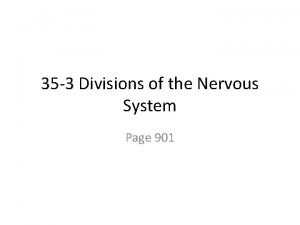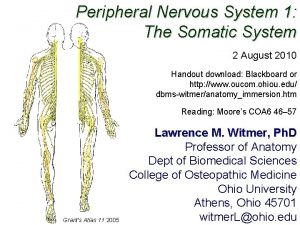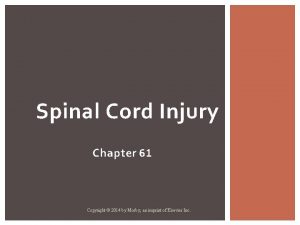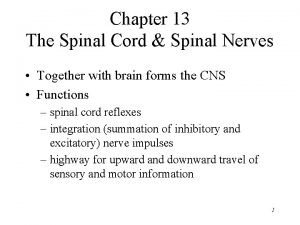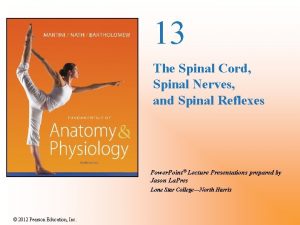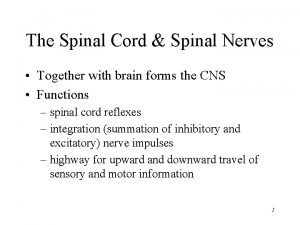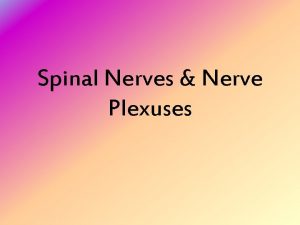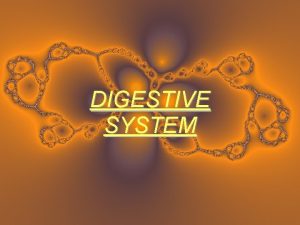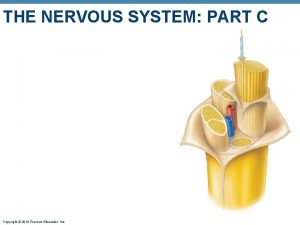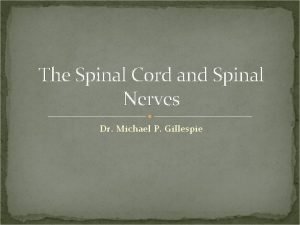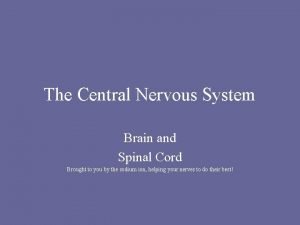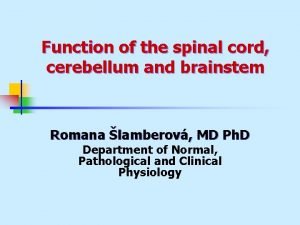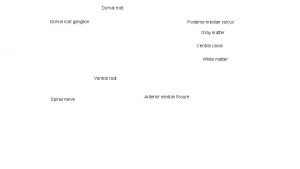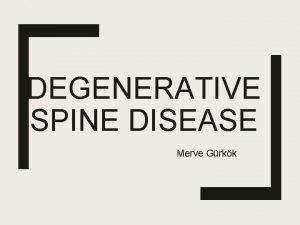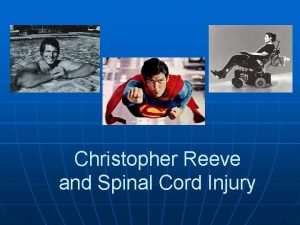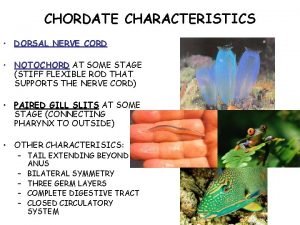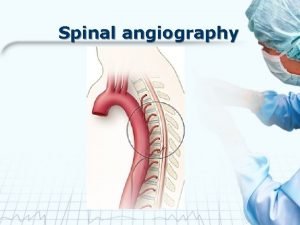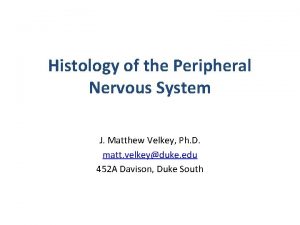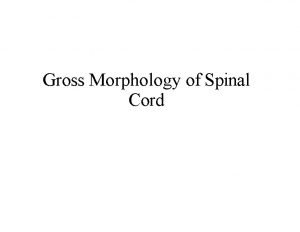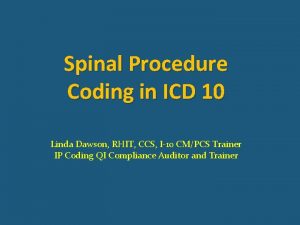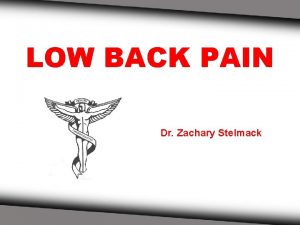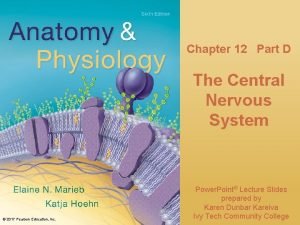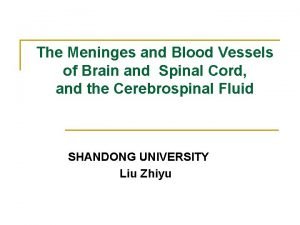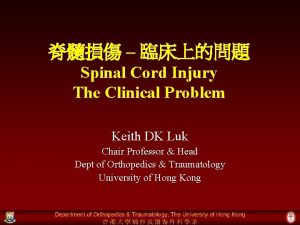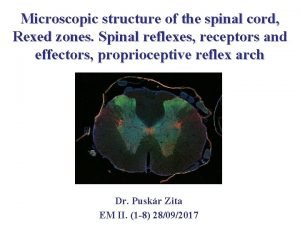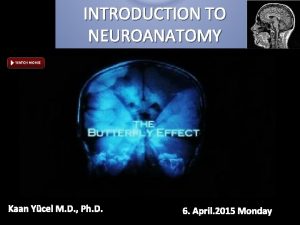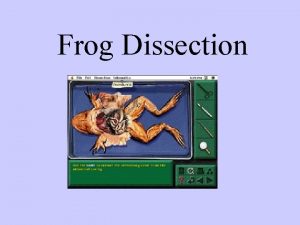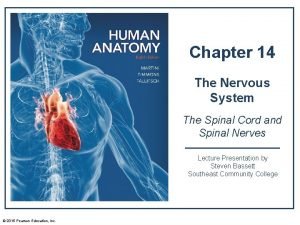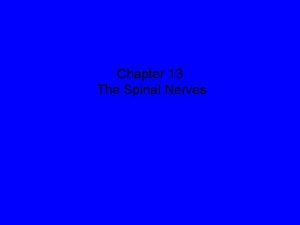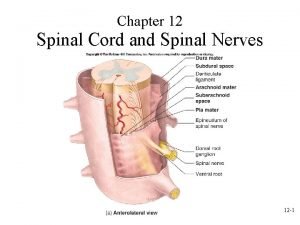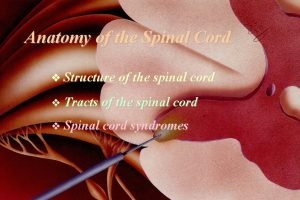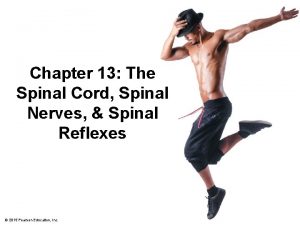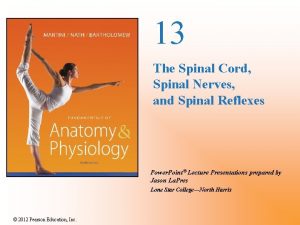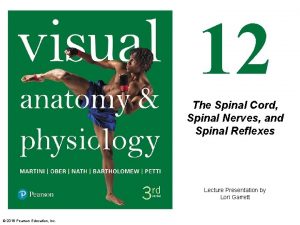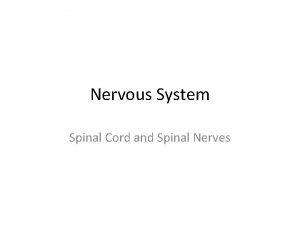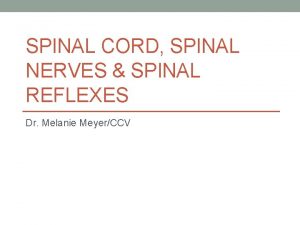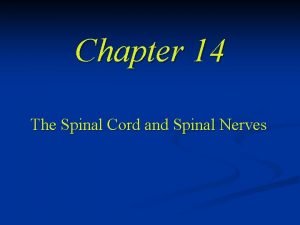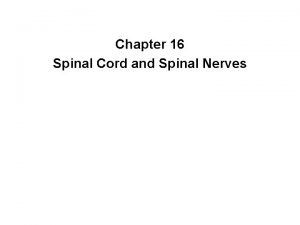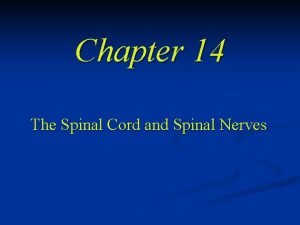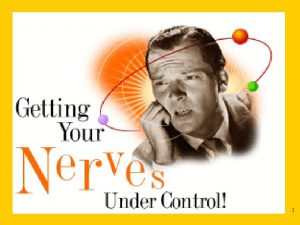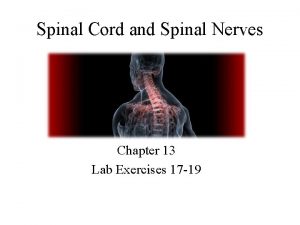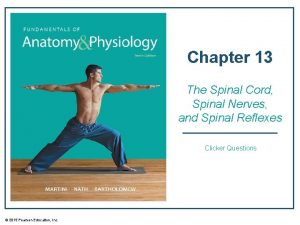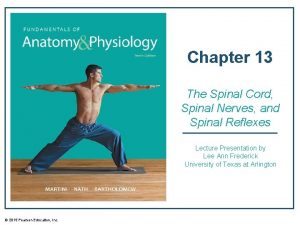Chapter 13 The Spinal Cord Spinal Nerves and

























































- Slides: 57

Chapter 13 The Spinal Cord, Spinal Nerves, and Spinal Reflexes Lecture Presentation by Lee Ann Frederick University of Texas at Arlington © 2015 Pearson Education, Inc.

An Introduction to the Spinal Cord, Spinal Nerves, and Spinal Reflexes • Learning Outcomes • 13 -1 Describe the basic structural and organizational characteristics of the nervous system. • 13 -2 Discuss the structure and functions of the spinal cord, and describe three meningeal layers that surround the central nervous system. • 13 -3 Explain the roles of white matter and gray matter in processing and relaying sensory information and motor commands. • 13 -4 Describe the major components of a spinal nerve, and relate the distribution pattern of spinal nerves to the regions they innervate. © 2015 Pearson Education, Inc.

An Introduction to the Spinal Cord, Spinal Nerves, and Spinal Reflexes • Learning Outcomes • 13 -5 Discuss the significance of neuronal pools, and describe the major patterns of interaction among neurons within and among these pools. • 13 -6 Describe the steps in a neural reflex, and classify the types of reflexes. • 13 -7 Distinguish among the types of motor responses produced by various reflexes, and explain how reflexes interact to produce complex behaviors. • 13 -8 Explain how higher centers control and modify reflex responses. © 2015 Pearson Education, Inc.

Figure 13 -1 An Overview of Chapters 13 and 14. CHAPTER 14: The Brain Sensory receptors Sensory input over cranial nerves Reflex centers in brain Motor output over cranial nerves Effectors Muscles CHAPTER 13: The Spinal Cord Glands Sensory receptors © 2015 Pearson Education, Inc. Sensory input over spinal nerves Reflex centers in spinal cord Motor output over spinal nerves Adipose tissue

13 -2 Spinal Cord • Gross Anatomy of the Spinal Cord • • About 18 inches (45 cm) long 1/2 inch (14 mm) wide Ends between vertebrae L 1 and L 2 Bilateral symmetry • Grooves divide the spinal cord into left and right • Posterior median sulcus – on posterior side • Anterior median fissure – deeper groove on anterior side © 2015 Pearson Education, Inc.

13 -2 Spinal Cord • Enlargements of the Spinal Cord • Caused by: • Amount of gray matter in segment • Involvement with sensory and motor nerves of limbs • Cervical enlargement • Nerves of shoulders and upper limbs • Lumbar enlargement • Nerves of pelvis and lower limbs © 2015 Pearson Education, Inc.

13 -2 Spinal Cord • Gross Anatomy of the Spinal Cord • The distal end • Conus medullaris • Thin, conical spinal cord below lumbar enlargement • Filum terminale • Thin thread of fibrous tissue at end of conus medullaris • Attaches to coccygeal ligament • Cauda equina • Nerve roots extending below conus medullaris © 2015 Pearson Education, Inc.

Figure 13 -2 Gross Anatomy of the Adult Spinal Cord. Posterior median sulcus Dorsal root ganglion Cervical spinal nerves C 1 C 2 C 3 C 4 C 5 C 6 C 7 C 8 White matter Central canal Cervical enlargement Gray matter Spinal Ventral nerve root Anterior median fissure C 3 T 1 T 2 T 3 T 4 T 5 T 6 T 7 KEY Spinal cord regions Thoracic spinal nerves T 8 T 9 = Cervical T 10 = Thoracic T 11 = Lumbar = Sacral T 12 L 1 Posterior median sulcus T 3 Lumbar enlargement Conus medullaris L 2 Lumbar spinal nerves L 3 Inferior tip of spinal cord L 4 Cauda equina L 5 L 1 Sacral spinal nerves S 1 S 2 S 3 S 4 S 5 Coccygeal nerve (Co 1) Filum terminale (in coccygeal ligament) S 2 b Inferior views of cross sections a The superficial anatomy and orientation of the adult spinal cord. The numbers to the left identify the spinal nerves and indicate where the nerve roots leave the vertebral canal. The adult spinal cord extends from the brain only to the level of vertebrae L 1–L 2; the spinal segments found at representative locations are indicated in the cross sections. © 2015 Pearson Education, Inc. through representative segments of the spinal cord, showing the arrangement of gray matter and white matter.

Figure 13 -2 Gross Anatomy of the Adult Spinal Cord (Part 3 of 4). L 1 Conus medullaris L 2 Lumbar spinal nerves L 3 Inferior tip of spinal cord L 4 Cauda equina L 5 L 1 a The superficial anatomy and orientation of the adult spinal cord. The numbers to the left identify the spinal nerves and indicate where the nerve roots leave the vertebral canal. The adult spinal cord extends from the brain only to the level of vertebrae L 1– L 2; the spinal segments found at representative locations are indicated in the cross sections. © 2015 Pearson Education, Inc. b Inferior views of cross sections through representative segments of the spinal cord, showing the arrangement of gray matter and white matter.

Figure 13 -2 Gross Anatomy of the Adult Spinal Cord (Part 4 of 4). Inferior tip of spinal cord Cauda equina Sacral spinal nerves S 1 S 2 S 3 S 4 S 5 Coccygeal nerve (Co 1) Filum terminale (in coccygeal ligament) a The superficial anatomy and orientation of the adult spinal cord. The numbers to the left identify the spinal nerves and indicate where the nerve roots leave the vertebral canal. The adult spinal cord extends from the brain only to the level of vertebrae L 1– L 2; the spinal segments found at representative locations are indicated in the cross sections. © 2015 Pearson Education, Inc. S 2 b Inferior views of cross sections through representative segments of the spinal cord, showing the arrangement of gray matter and white matter.

13 -2 Spinal Cord • 31 Spinal Cord Segments • Based on vertebrae where spinal nerves originate • Positions of spinal segment and vertebrae change with age • Cervical nerves except the 8 th • Named for inferior vertebra • All other nerves • Named for superior vertebra © 2015 Pearson Education, Inc.

13 -2 Spinal Cord • Roots • Two branches of spinal nerves 1. Ventral root • Contains axons of motor neurons 2. Dorsal root • Contains axons of sensory neurons • Dorsal root ganglia • Contain cell bodies of sensory neuron © 2015 Pearson Education, Inc.

13 -2 Spinal Cord • The Spinal Nerve • Each side of spine • Dorsal and ventral roots join • To form a spinal nerve • Are Mixed Nerves • Carry both afferent (sensory) and efferent (motor) fibers © 2015 Pearson Education, Inc.

Figure 13 -3 a The Spinal Cord and Spinal Meninges. White matter Ventral rootlets of spinal nerve Gray matter Dorsal root ganglion Ventral root Spinal nerve Dorsal rootlets of spinal nerve Meninges Pia mater Arachnoid mater Dura mater a A posterior view of the spinal cord, showing the meningeal layers, superficial landmarks, and distribution of gray matter and white matter © 2015 Pearson Education, Inc.

Figure 13 -3 b The Spinal Cord and Spinal Meninges ANTERIOR Subarachnoid space Vertebral body Rami communicantes Dura mater Arachnoid mater Pia mater Autonomic (sympathetic) ganglion Ventral root of spinal nerve Ventral ramus Dorsal ramus Spinal cord Adipose tissue in epidural space Denticulate Dorsal root ganglion ligament POSTERIOR b A sectional view through the spinal cord and meninges, showing the relationship of the meninges, spinal cord, and spinal nerves © 2015 Pearson Education, Inc.

13 -2 Spinal Cord • The Spinal Meninges • Specialized membranes isolate spinal cord from surroundings • Functions of the spinal meninges include: • Protecting spinal cord • Carrying blood supply • Continuous with cranial meninges • Meningitis • Viral or bacterial infection of meninges © 2015 Pearson Education, Inc.

13 -2 Spinal Cord • The Three Meningeal Layers 1. Dura mater • Outer layer of spinal cord 2. Arachnoid mater • Middle meningeal layer 3. Pia mater • Inner meningeal layer © 2015 Pearson Education, Inc.

13 -2 Spinal Cord • Epidural space • Between spinal dura mater and walls of vertebral canal. (Anesthetic injection site) • Subdural space • Between arachnoid mater and dura mater • Subarachnoid space • Between arachnoid mater and pia mater • Contains collagen/elastin fiber network (arachnoid trabeculae) • Filled with cerebrospinal fluid (CSF) © 2015 Pearson Education, Inc.

13 -2 Spinal Cord • Cerebrospinal Fluid (CSF) • Carries dissolved gases, nutrients, and wastes • Lumbar puncture or spinal tap withdraws CSF © 2015 Pearson Education, Inc.

13 -3 Gray Matter and White Matter • Sectional Anatomy of the Spinal Cord • White matter • Is superficial • Contains myelinated and unmyelinated axons • Gray matter • Surrounds the central canal of spinal cord • Contains neuron cell bodies, neuroglia, unmyelinated axons • Is a site for integration of postsynaptic potentials (IPSPs and EPSPs) © 2015 Pearson Education, Inc.

13 -3 Gray Matter and White Matter • Organization of Gray Matter • The gray horns • Posterior gray horns contain somatic and visceral sensory nuclei • Anterior gray horns contain somatic motor nuclei • Lateral gray horns are in thoracic and lumbar segments; contain visceral motor nuclei • Gray commissures • Axons that cross from one side of cord to the other before reaching gray matter © 2015 Pearson Education, Inc.

13 -3 Gray Matter and White Matter • Organization of White Matter • Posterior white columns lie between posterior gray horns and posterior median sulcus • Anterior white columns lie between anterior gray horns and anterior median fissure • Anterior white commissure is area where axons cross from one side of spinal cord to the other • Lateral white columns located on each side of spinal cord between anterior and posterior columns © 2015 Pearson Education, Inc.

13 -3 Gray Matter and White Matter • Organization of White Matter • Tracts or fasciculi • Bundles of axons • Relay same information in same direction • contains major sensory and motor tracts to and from the brain: • Ascending tracts • Carry information to brain • Descending tracts • Carry motor commands to spinal cord © 2015 Pearson Education, Inc.

Figure 13 -5 a The Sectional Organization of the Spinal Cord (Part 1 of 2). Posterior white column Posterior gray horn Dorsal root ganglion Lateral white column Lateral gray horn Anterior white column a The left half of this sectional view shows important anatomical landmarks, including the three columns of white matter. The right half indicates the functional organization of the nuclei in the anterior, lateral, and posterior gray horns. © 2015 Pearson Education, Inc.

Figure 13 -5 a The Sectional Organization of the Spinal Cord (Part 2 of 2). Posterior median sulcus Posterior gray commissure Somatic Functional Organization of Gray Matter The cell bodies of neurons in the gray matter of the spinal cord are organized into functional groups called nuclei. Sensory nuclei Visceral Motor nuclei Somatic Ventral root Anterior gray commissure Anterior white commissure Anterior median fissure a The left half of this sectional view shows important anatomical landmarks, including the three columns of white matter. The right half indicates the functional organization of the nuclei in the anterior, lateral, and posterior gray horns. © 2015 Pearson Education, Inc.

13 -4 Spinal Nerves and Plexuses • Three Connective Tissue Layers of Spinal Nerves 1. Epineurium • Outer layer • Dense network of collagen fibers 2. Perineurium • Middle layer • Divides nerve into fascicles (axon bundles) 3. Endoneurium • Inner layer • Surrounds individual axons © 2015 Pearson Education, Inc.

Figure 13 -6 a A Peripheral Nerve. Blood vessels Connective Tissue Layers Epineurium covering peripheral nerve Perineurium (around one fascicle) Endoneurium Schwann cell Myelinated axon Fascicle a A typical peripheral nerve and its connective tissue wrappings © 2015 Pearson Education, Inc.

Figure 13 -8 Peripheral Distribution of Spinal Nerves (Part 2 of 2). To skeletal muscles of back Postganglionic fibers to smooth muscles, glands, etc. , of back 2 The spinal nerve forms just lateral to the intervertebral foramen, where the dorsal and ventral roots unite. 3 Dorsal root ganglion 4 1 The ventral root of each spinal nerve contains the axons of somatic motor and visceral motor neurons. The dorsal ramus contains somatic motor and visceral motor fibers that innervate the skin and skeletal muscles of the back. The axons in the relatively large ventral ramus supply the ventrolateral body surface, structures in the body wall, and the limbs. Visceral motor nuclei To skeletal muscles of body wall, limbs Somatic motor nuclei Rami communicantes KEY = Somatic motor commands = Visceral motor commands Postganglionic fibers to smooth muscles, glands, visceral organs in thoracic cavity Preganglionic fibers to sympathetic ganglia innervating abdominopelvic viscera © 2015 Pearson Education, Inc. Sympathetic ganglion 7 Postganglionic fibers to smooth muscles, and glands of body wall, limbs 5 The white ramus communicans is the first branch from the spinal nerve and carries visceral motor fibers to a nearby sympathetic ganglion. Because these preganglionic axons are myelinated, this branch has a light color and is therefore known as the white ramus. White rami are only found between T 1 and L 2. A sympathetic nerve contains preganglionic and postganglionic fibers innervating structures in the thoracic cavity. 1 6 The gray ramus communicans contains preganglionic fibers that innervate glands and smooth muscles in the body wall or limbs. These fibers are unmyelinated and have a dark gray color. Gray rami are associated with each spinal nerve.

Figure 13 -8 Peripheral Distribution of Spinal Nerves (Part 1 of 2). From interoceptors of back 4 From exteroceptors, proprioceptors of back The dorsal root of each spinal nerve carriers sensory information to the spinal cord. 3 The dorsal ramus carries sensory information from the skin and skeletal muscles of the back. Somatic sensory nuclei 2 The ventral ramus carries sensory information from the ventrolateral body surface, structures in the body, wall, and the limbs. Dorsal root ganglion From exteroceptors, proprioceptors of body wall, limbs From interoceptors of body wall, limbs Rami communicantes Ventral root KEY = Somatic sensations = Visceral sensations © 2015 Pearson Education, Inc. Visceral sensory nuclei 1 The sympathetic nerve carriers sensory information from the visceral organs. From interceptors of visceral organs

13 -4 Spinal Nerves and Plexuses • Dermatomes • Bilateral region of skin • Monitored by specific pair of spinal nerves © 2015 Pearson Education, Inc.

Figure 13 -7 Dermatomes. NV C 2–C 3 C 2 C 3 T 2 C 6 L 1 L 2 C 8 T 1 C 7 L 3 L 4 KEY Spinal cord regions L 5 C 3 C 4 C 5 T 1 T 2 T 3 T 4 T 5 T 6 T 7 T 8 T 9 T 10 T 11 T 12 S 2 T 3 T 4 T 5 T 6 T 7 T 8 T 9 T 10 T 11 T 12 L 1 L 2 L 4 L 3 L 5 C 4 C 5 T 2 C 6 T 1 C 7 S 4 S 3 L 1 S 5 C 8 S 1 L 5 L 2 S 2 L 3 = Cervical = Thoracic = Lumbar S 1 = Sacral L 4 ANTERIOR © 2015 Pearson Education, Inc. POSTERIOR

13 -4 Spinal Nerves and Plexuses • Nerve Plexuses • Complex, interwoven networks of nerve fibers • Formed from blended fibers of ventral rami of adjacent spinal nerves • Control skeletal muscles of the neck and limbs © 2015 Pearson Education, Inc.

13 -4 Spinal Nerves and Plexuses • The Four Major Plexuses of Ventral Rami 1. 2. 3. 4. Cervical plexus Brachial plexus Lumbar plexus Sacral plexus © 2015 Pearson Education, Inc.

Figure 13 -9 Peripheral Nerves and Nerve Plexuses (Part 1 of 2). Cervical plexus Brachial plexus C 1 C 2 C 3 C 4 C 5 C 6 C 7 C 8 T 1 T 2 T 3 T 4 T 5 T 6 T 7 Supraclavicular nerve Phrenic nerve Axillary nerve T 8 Musculocutaneous nerve T 9 Thoracic nerves T 10 T 11 © 2015 Pearson Education, Inc. Lesser occipital nerve Great auricular nerve Transverse cervical nerve

Figure 13 -9 Peripheral Nerves and Nerve Plexuses (Part 2 of 2). T 12 L 1 Lumbar plexus Radial nerve L 2 Ulnar nerve L 3 Median nerve L 4 Sacral plexus L 5 S 1 S 2 S 3 S 4 S 5 Co 1 Iliohypogastric nerve Ilioinguinal nerve Lateral femoral cutaneous nerve Genitofemoral nerve Femoral nerve Obturator nerve Superior Inferior Gluteal nerves Pudendal nerve Saphenous nerve Sciatic nerve © 2015 Pearson Education, Inc.

13 -6 Reflexes • Automatic responses coordinated within spinal cord • Through interconnected sensory neurons, motor neurons, and interneurons • Produce simple and complex reflexes © 2015 Pearson Education, Inc.

13 -6 Reflexes • Neural Reflexes • • Rapid, automatic responses to specific stimuli Basic building blocks of neural function One neural reflex produces one motor response Reflex arc • • The wiring of a single reflex Beginning at receptor Ending at peripheral effector Generally opposes original stimulus (negative feedback) © 2015 Pearson Education, Inc.

13 -6 Reflexes • Five Steps in a Neural Reflex • Step 1: Arrival of stimulus, activation of receptor • Physical or chemical changes • Step 2: Activation of sensory neuron • Graded depolarization • Step 3: Information processing by postsynaptic cell • Triggered by neurotransmitters • Step 4: Activation of motor neuron • Action potential • Step 5: Response of peripheral effector • Triggered by neurotransmitters © 2015 Pearson Education, Inc.

Figure 13 -14 Spinal Reflexes (Part 1 of 4). 1 Arrival of stimulus and activation of receptor 2 Dorsal root Activation of a sensory neuron Sensation relayed to the brain by axon collaterals Spinal cord Stimulus Receptor 3 Information processing in the CNS REFLEX ARC 5 Response by a peripheral effector Effector 4 Ventral root Activation of a motor neuron © 2015 Pearson Education, Inc. KEY Sensory neuron (stimulated) Excitatory interneuron Motor neuron (stimulated)

13 -6 Reflexes • Four Classifications of Reflexes 1. 2. 3. 4. By early development By type of motor response By complexity of neural circuit By site of information processing © 2015 Pearson Education, Inc.

13 -6 Reflexes • Development of Reflexes • Innate reflexes • Basic neural reflexes formed before birth • Acquired reflexes • Rapid, automatic, learned motor patterns © 2015 Pearson Education, Inc.

13 -6 Reflexes • Motor Response • Nature of resulting motor response • Somatic reflexes • Involuntary control of nervous system • Superficial reflexes of skin, mucous membranes • Stretch or deep tendon reflexes (e. g. , patellar, or “knee-jerk, ” reflex) • Visceral reflexes (autonomic reflexes) • Control systems other than muscular system © 2015 Pearson Education, Inc.

13 -6 Reflexes • Complexity of Neural Circuit • Monosynaptic reflex • Sensory neuron synapses directly onto motor neuron • Polysynaptic reflex • At least one interneuron between sensory neuron and motor neuron © 2015 Pearson Education, Inc.

13 -6 Reflexes • Sites of Information Processing • Spinal reflexes • Occur in spinal cord • Cranial reflexes • Occur in brain © 2015 Pearson Education, Inc.

Figure 13 -15 The Classification of Reflexes can be classified by development Innate Reflexes • Genetically determined Acquired Reflexes • Learned response complexity of circuit processing site Somatic Reflexes Monosynaptic Spinal Reflexes • Control skeletal muscle contractions • Include superficial and stretch reflexes Visceral (Autonomic) Reflexes • Control actions of smooth and cardiac muscles, glands, and adipose tissue © 2015 Pearson Education, Inc. • One synapse Polysynaptic • Multiple synapses (two to several hundred) • Processing in the spinal cord Cranial Reflexes • Processing in the brain

13 -7 Spinal Reflexes • Range in increasing order of complexity • Monosynaptic reflexes • Polysynaptic reflexes • Intersegmental reflex arcs • Many segments interact • Produce highly variable motor response © 2015 Pearson Education, Inc.

13 -7 Spinal Reflexes • Monosynaptic Reflexes • A stretch reflex • Have least delay between sensory input and motor output • For example, stretch reflex (such as patellar reflex) • Completed in 20– 40 msec • Receptor is muscle spindle © 2015 Pearson Education, Inc.

Figure 13 -14 Spinal Reflexes (Part 2 of 4). Stretch Receptor (muscle spindle) Spinal cord REFLEX ARC Stimulus Contraction Effector KEY Response © 2015 Pearson Education, Inc. Sensory neuron (stimulated) Motor neuron (stimulated)

13 -7 Spinal Reflexes • Postural Reflexes • Stretch reflexes • Maintain normal upright posture • Stretched muscle responds by contracting • Automatically maintains balance © 2015 Pearson Education, Inc.

13 -7 Spinal Reflexes • Polysynaptic Reflexes • More complicated than monosynaptic reflexes • Interneurons control more than one muscle group • Produce either EPSPs or IPSPs © 2015 Pearson Education, Inc.

13 -7 Spinal Reflexes • The Tendon Reflex • Prevents skeletal muscles from: • Developing too much tension • Tearing or breaking tendons © 2015 Pearson Education, Inc.

13 -7 Spinal Reflexes • Withdrawal Reflexes • Move body part away from stimulus (pain or pressure) • For example, flexor reflex • Pulls hand away from hot stove © 2015 Pearson Education, Inc.

Figure 13 -14 Spinal Reflexes (Part 3 of 4). Distribution within gray horns to other segments of the spinal cord Painful stimulus Flexors stimulated Extensors inhibited © 2015 Pearson Education, Inc.

13 -7 Spinal Reflexes • Reciprocal Inhibition • For flexor reflex to work • The stretch reflex of antagonistic (extensor) muscle must be inhibited (reciprocal inhibition) by interneurons in spinal cord © 2015 Pearson Education, Inc.

13 -7 Spinal Reflexes • Reflex Arcs • Ipsilateral reflex arcs • Occur on same side of body as stimulus • Stretch, tendon, and withdrawal reflexes • Crossed extensor reflexes • Involve a contralateral reflex arc • Occur on side opposite stimulus © 2015 Pearson Education, Inc.

13 -7 Spinal Reflexes • Crossed Extensor Reflexes • Occur simultaneously, coordinated with flexor reflex • For example, flexor reflex causes leg to pull up • Crossed extensor reflex straightens other leg • To receive body weight • Maintained by reverberating circuits © 2015 Pearson Education, Inc.

Figure 13 -14 Spinal Reflexes (Part 4 of 4). To motor neurons in other segments of the spinal cord Extensors inhibited Flexors stimulated Extensors stimulated Flexors inhibited KEY Sensory neuron (stimulated) Motor neuron (inhibited) Excitatory interneuron Inhibitory interneuron Motor neuron (stimulated) © 2015 Pearson Education, Inc. Painful stimulus
 Exercise 15 spinal cord and spinal nerves
Exercise 15 spinal cord and spinal nerves Lateral pectoral nerve
Lateral pectoral nerve Spinal cord and spinal nerves exercise 15
Spinal cord and spinal nerves exercise 15 Nerves branching beyond the spinal cord into the body
Nerves branching beyond the spinal cord into the body Figure 13-2 spinal nerves labeled
Figure 13-2 spinal nerves labeled Foramen costo transversarium
Foramen costo transversarium Spinal cord and brain
Spinal cord and brain Pns
Pns Somi brace
Somi brace Visceral reflex
Visceral reflex What is the spinal cord made of
What is the spinal cord made of Cover of spinal cord
Cover of spinal cord Nerve regions of the body
Nerve regions of the body Figure 13-2 spinal nerves
Figure 13-2 spinal nerves Spinal nerves
Spinal nerves Spinal segment
Spinal segment Spinal cord anatomy
Spinal cord anatomy Urinary bladder
Urinary bladder Spinal cord anatomy
Spinal cord anatomy Brain nervous system
Brain nervous system Nervous system parts
Nervous system parts Spinal cord denticulate ligament
Spinal cord denticulate ligament Spinal cord structures
Spinal cord structures Causes of spinal cord compression
Causes of spinal cord compression Spinal cord
Spinal cord Cerebellum nuclei
Cerebellum nuclei Median furrow
Median furrow Intervertebral disc prolapse
Intervertebral disc prolapse Christopher reeve spinal cord injury level
Christopher reeve spinal cord injury level Bird air sac
Bird air sac Gray commissure of spinal cord
Gray commissure of spinal cord Vestibulospinal tract
Vestibulospinal tract Babinski sign
Babinski sign Spinalni disrafizam
Spinalni disrafizam Spinal arteries
Spinal arteries Spinal cord
Spinal cord Spinal cord
Spinal cord Stretch reflex
Stretch reflex Morphology of spinal cord
Morphology of spinal cord Eat well live well
Eat well live well Coding procedure
Coding procedure Intensivis
Intensivis Low back rom
Low back rom Spinal cord cross section
Spinal cord cross section Cerebellomedullary cistern
Cerebellomedullary cistern Christopher reeve ventilator
Christopher reeve ventilator Spinal cord structure
Spinal cord structure Spinal cord injury shoulder exercises
Spinal cord injury shoulder exercises Tendon histology
Tendon histology Anconeus
Anconeus Dendirite
Dendirite Frog spleen
Frog spleen Medullary pyramids
Medullary pyramids Spinal cord anterior
Spinal cord anterior Spinal cord nerve anatomy
Spinal cord nerve anatomy Spine meninges
Spine meninges Subthalamus
Subthalamus Spinal cord
Spinal cord






